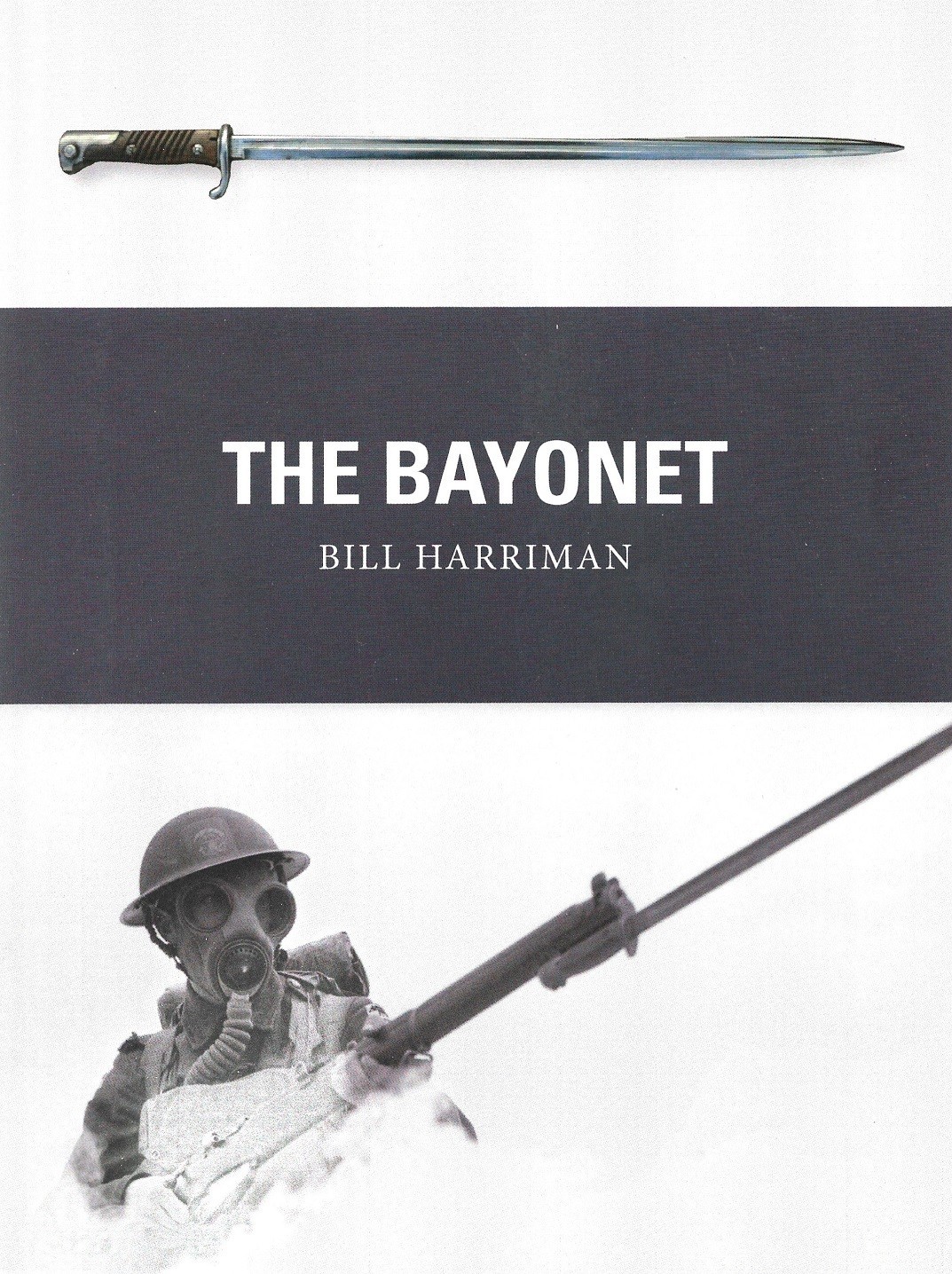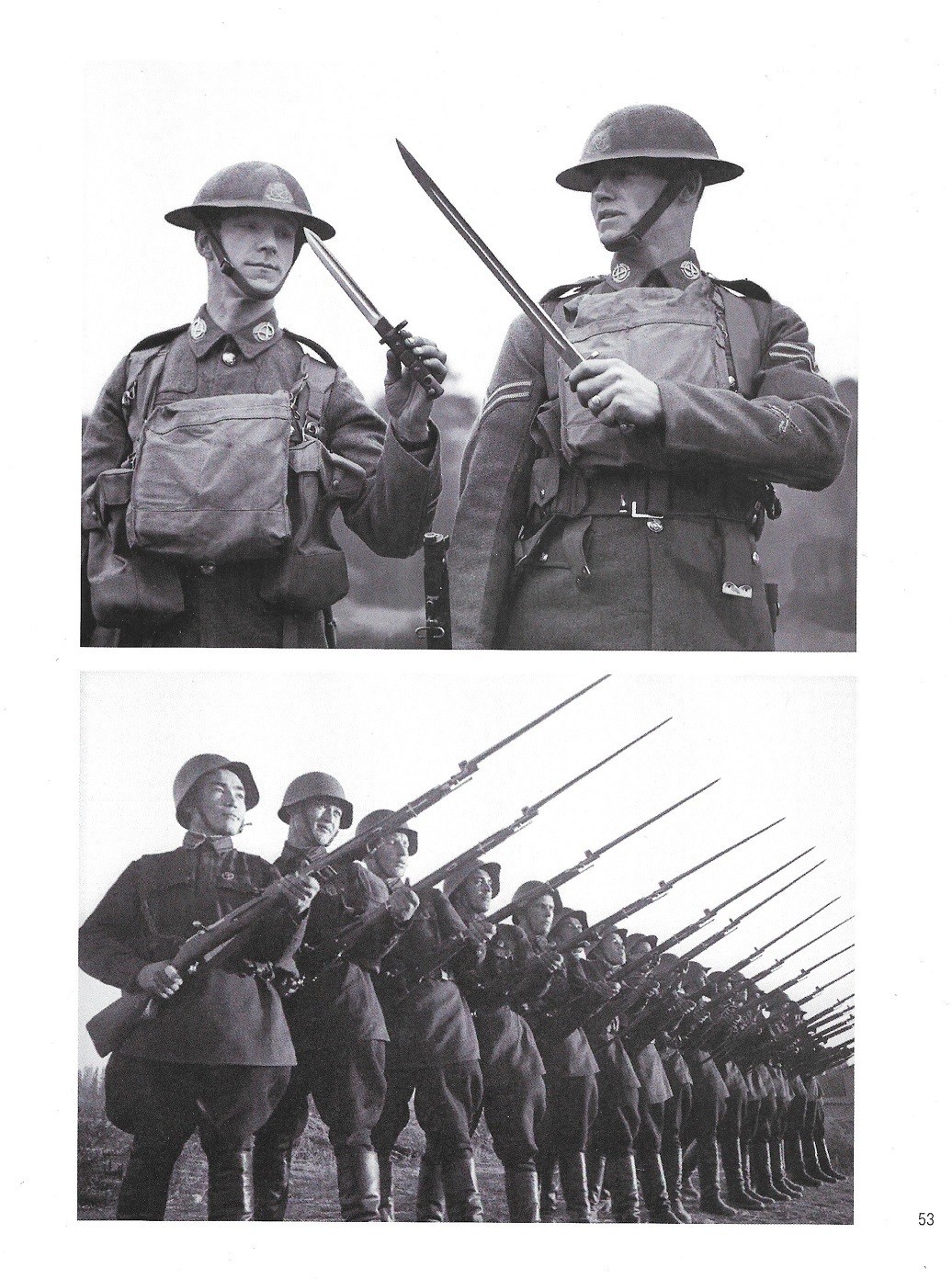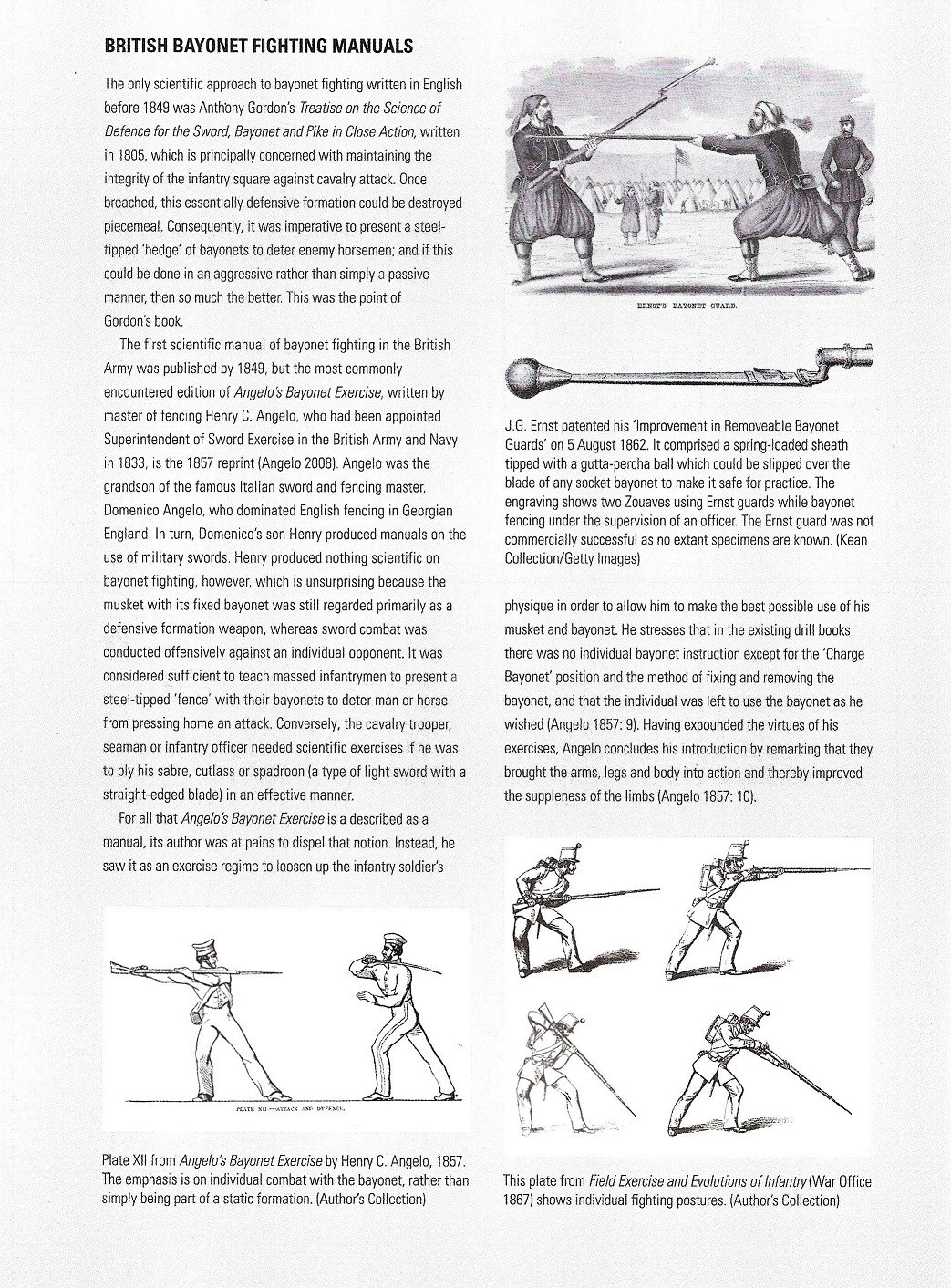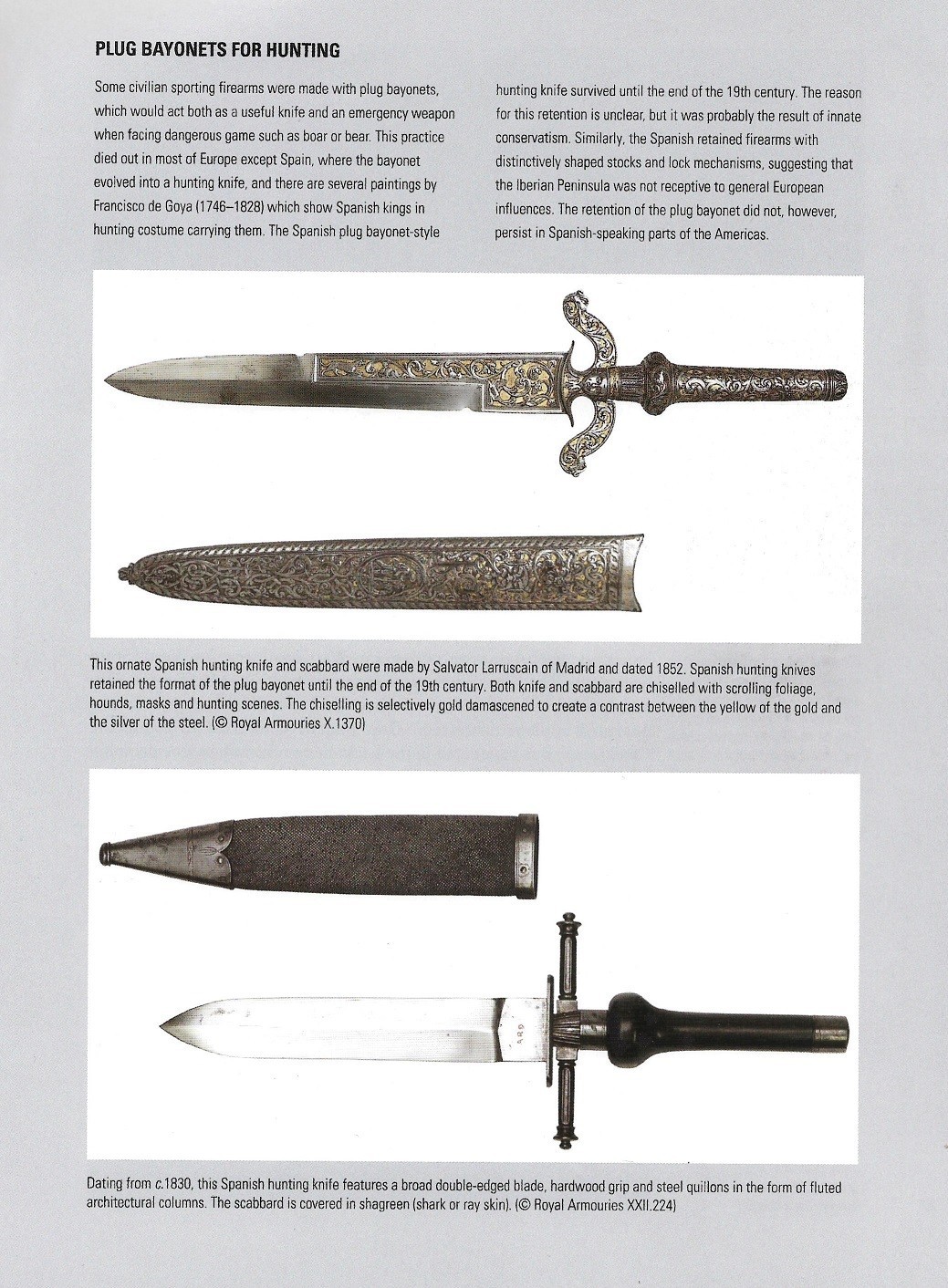HISTORY:
** In the last years of the 17th century the bayonet transformed the cumbersome musket into an effective close-quarter weapon and changed the face of infantry combat. The plug bayonet, essentially a short knife jammed into the musket’s muzzle, was soon replaced by the socket bayonet, which allowed the soldier to fire his musket with the blade attached, and the musket/bayonet combination became the standard infantry weapon for nearly 150 years. As smoothbore muskets gave way to universally issued rifles in the years after 1850, many infantrymen employed sword-bayonets, their longer blades giving the ‘reach’ that contemporaries believed necessary to fend off cavalry attacks. The perfection of the small-bore magazine rifle in the 1890s saw the bayonet become smaller and more knife-like, a trend that continued throughout both world wars. When assault rifles predominated from the 1950s onwards, the bayonet became a weapon of last resort, its blade often combined with an item of additional function, most notably a wire-cutter. Featuring full-colour artwork as well as archive and close-up photographs, this is the absorbing story of the complementary weapon to every soldier’s firearm from the army of Louis XIV to modern-day forces in all global theatres if conflict. **
** Quoted from the back cover of the book.
THE BOOK:
Osprey Publications has released The Bayonet as Number 78 in their Weapon series. It is a soft cover book with 80 pages. Included with the text are black and white photographs, color illustrations, detailed captions and more. It has a 2021 copyright, a publication date of April 15, 2021 and the ISBN is 978-1-4728-4536-8.
THE CONTENTS:
- Introduction
- Development
- Blades for firearms
- Use
- The bayonet goes to war
- Impact
- The bayonet’s reach
- Conclusion
- Glossary
- Bibliography
- Index
THE TEXT:
Author Bill Harriman provides a well written text detailing various types of military bayonets such as the plug, socket, sword, spring, Yataghan, trowel, rod and saw backed bayonets, from their origins to modern day use. The specific bayonets featured have detailed text discussing things such as their country of origin and specific manufacturers, how they were attached to the rifle, which military used them as well as the positive aspects of the bayonets and their failures and short-comings and necessary changes and improvements made to them, practicality and impracticality of various types, and specific military actions some of the bayonets were used in and the results of the actions due to the use of the bayonets such as casualties and the psychological effect on the enemy. Bill Harriman details the dual-purpose use of some of the various bayonets such as those designed to also be used as entrenching tools, wire cutters, hunting knives and wood saws in addition to their main role of being a secondary weapon giving individuals an additional method of inflicting injuries and giving them additional weapon reach/distance to help keep an enemy at bay. Also discussed is technical information such as how muzzleloader rifles had to be loaded with a bayonet attached and how some types of bayonets hampered the loading process, the weight of bayonets and how attached bayonets could affect the performance of the weapons due to the additional weight the bayonets created on the muzzle end of the rifle. Another area of interest is the detailing of bayonet training in various militaries and training devices used such as the Ernst Guard. Also discussed is how some bayonets were issued without scabbards with the intention that the bayonet was to be permanently attached to the rifle. In addition to discussing various bayonets, Bill Harriman also discusses and details items such as bayonet scabbards, bayonet frogs and bayonet knots (Troddeln or tassel) as well as retention and attachment devices. Along with his own words Bill Harriman has also provided accounts from individuals as well as quotes from various period military manuals. The text in the book is nicely written and well detailed. As I read through the text, I didn’t notice any spelling errors but I did find a couple of grammatical errors. However, they are minor and take nothing away from the book. Grammar and spelling might not be an important factor to everyone however it is something that I take notice of and pass on my findings. I feel that if the text is well written then it shows that the author has taken the time to be professional with their writing. Anyone wanting to add an excellent reference and history book on various countries bayonets and their use throughout history to their personal library will be pleased with this informative book.
THE PHOTOGRAPHS:
A total of 26 black and white photographs and 57 color photographs are included in this volume. The photographs range from wide angle photographs to close-up detailed photographs. I would say that the photographs that were chosen for this book were for the most part lesser-known photographs as opposed to photographs that are featured in many other titles that deal with the same subject matter. The majority of the photographs are clear and easily viewable, however a few have an out of focus look to them and some appear to be too dark, and others appear too light. This is typical for the discussed periods of history and consideration needs to be given to the fact that some of the photographs are over one hundred years old and the quality of the photographs is of no fault of the author and do not take anything away from the book. Author Bill Harriman stuck to the title of the book and chose subject specific photographs and did not include photographs that strayed from the main subject of the book. The majority, if not all, of the photographs will prove to be a wealth of information to anyone interested in bayonets and edged weaponry as well as the uniforms, firearms and warfare of the periods discussed due to the details they contain.
THE ILLUSTRATIONS:
There are 4 color illustrations included in the volume by illustrators Adam Hook and Alan Gilliland. The illustrations are very well done, nicely detailed and are of:
Plate A
Bayonet evolution
- One-page illustration featuring eight different bayonets.
- Austrian plug bayonet c.1680
- Winchester Model 1866 socket bayonet
- Chassepot Mle 1866 Yatoghan bayonet
- Mosin-Nagant M1891 Schtyk socket bayonet
- Austro-Hungarian Mannlicher M1895 short blade bayonet
- US Model 1905 Springfield long straight-bladed sword bayonet
- Japanese Type 30 Arisaka long straight-bladed sword bayonet
- US M9 short-bladed multi-purpose tool bayonet
Plate B
Plug bayonet versus socket bayonet
- One-page action illustration depicting two Swedish infantry men armed with flintlock rifles fixed with socket bayonets search a woodland area searching for Russian fugitives during the Great Northern War of 1700-1721. In the foreground of the illustration there are two Russian infantrymen taking cover behind trees. One of the Russians is armed with a flintlock musket with a socket bayonet attached. The other Russian is armed with a Baltic Lock musket and is in the process of inserting a sword plug bayonet into the muskets barrel.
Plate C
Bayonet clash, American Civil War
- A two-page action scene depicting a dismounted Union cavalryman armed with a .64 Model 1833 hall carbine with extended rod bayonet engaging a Confederate soldier armed with a .54 Model 1841 ‘Mississippi’ rifle fitted with an M1855 yataghan bayonet. Also shown is a Confederate soldier armed with a .577 Pattern 1853 Enfield rifle-musket fitted with a conventional socket bayonet engaging a Union soldier armed with a 13.9mm M1854 Lorenz rifle fitted with an Austro-Hungarian M1854 Haubajonett ‘hewing bayonet’.
Plate D
Forest ambush, 1914
- A two-page action illustration depicting a French patrol of three French soldiers armed with 8mm Mle 1886/M93 rifles fitted with white-metal-hilted Mle 1886 bayonets surprising two German soldiers, an infantryman armed with a Mauser rifle fitted with a Mauser S 98 bayonet and a pioneer using the back of his saw-toothed Mauser S 98/05 bayonet to cut a tree branch during the early weeks of WWI.
THE CAPTIONS:
The captions are well written and explain the accompanying photographs and illustrations in great detail eliminating any doubt as to what is shown. The captions go into very specific detail as to the specific type of bayonet shown and its country of origin, the type of weapon it was designed to be attached to, dates of use, locations shown and other such pertinent information. As I read through the captions, I didn’t notice any spelling errors but I did find one grammatical error. I was impressed by Bill Harriman’s captions as they are very helpful to the reader due to their detailed content as opposed to other captions that I have seen that are very brief and lacking in detail.
NOTES:
There 2 notes note included in this volume and they are:
- The Royal Armouries
- Artist’s note
Osprey Publishing also offers The Bayonet as:
eBook (ePub) ISBN: 978-1-4728- 4537-5
and
eBook (PDF) ISBN: 978-1-4728- 4534-4
Osprey Publishing’s, The Bayonet is also available as a Kindle version through Amazon.com
PRICE:
UK £13.99 / US $22.00 / CAN $30.00
This book was provided to me by Osprey Publishing. Please be sure to mention that you saw the book reviewed here on the KitMaker Network when you make your purchase. Thank you.

































